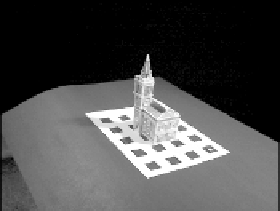Graphics Reference
In-Depth Information
(a)
(b)
(c)
(d)
(e)
(f)
Fig. 10.21.
Reconstruction of the Ghirardelli image sequence using Embedded
Voxel Colouring (EVC) and adaptive thresholding via GMS. Images (a) and (d)
are selected images from the Ghirardelli image set. Images (b), (c), (e), and (f) are
new views generated from the 3D reconstruction (from [105, 104]).
shows a 3D reconstruction from multiview images using GMS as a postpro-
cessor.
One advantage of the GMS algorithm for extraordinarily dicult segmen-
tation tasks, such as extracting the hippocampus from MRI images, is the
ability to define multiple sources and sinks to mark points that are definitely
interior and exterior to the object undergoing segmentation as shown in Figure
10.22. Franklin [64] used this approach to guide the GMS algorithm so that
the hippocampi of sets of human brains could be labeled fully automatically
as shown in Figure 10.23. This study has now been completed on a small set
of brains, yielding quite good results. It will be extended to a much larger set
in the near future.
This latter work is important because there is evidence that changes in the
shape of the hippocampi may be an early indicator of the onset of Alzheimer's
disease (also known as dementia). The economic and social cost of Alzheimer's
disease is growing rapidly due to the aging population in the western world. In-
deed, Access Economics estimates that the cost of dementia to the Australian
economy alone in 2004 was approximately USD 4 billion [90]. At present, the
detection of Alzheimer's disease is largely performed through psychological
tests that detect loss of cognitive ability once the brain is damaged. What






Search WWH ::

Custom Search